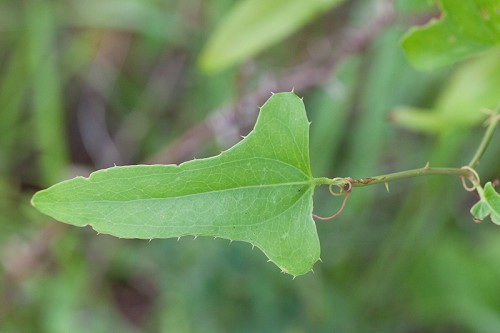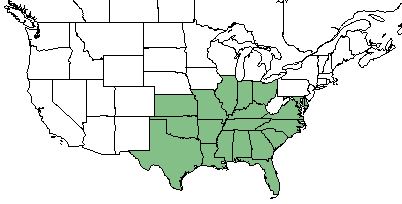Difference between revisions of "Smilax bona-nox"
(→Ecology) |
ParkerRoth (talk | contribs) (→Description) |
||
| (21 intermediate revisions by 6 users not shown) | |||
| Line 1: | Line 1: | ||
{{italic title}} | {{italic title}} | ||
| + | Common Names: Saw Greenbrier<ref name= "USDA"> [https://plants.usda.gov/core/profile?symbol=CEAM USDA Plant Database]</ref>, Catbrier, Bullbrier<ref name= "Gee">Gee, K. L., et al. (1994). White-tailed deer: their foods and management in the cross timbers. Ardmore, OK, Samuel Roberts Noble Foundation.</ref> | ||
<!-- Get the taxonomy information from the NRCS Plants database --> | <!-- Get the taxonomy information from the NRCS Plants database --> | ||
{{taxobox | {{taxobox | ||
| Line 18: | Line 19: | ||
}} | }} | ||
==Taxonomic Notes== | ==Taxonomic Notes== | ||
| − | Synonym: | + | Synonym: none |
| − | Variety: ''S. bona-nox'' var. ''littoralis'' (Coker ex Sorrie) | + | Variety: ''S. bona-nox'' var. ''littoralis'' (Coker ex Sorrie); ''S. bona-nox'' var. ''exauriculata'' (Fernald), ''S. bona-nox'' var. ''hederifolia'' (Beyrich) Fernald |
==Description== | ==Description== | ||
| − | '' | + | ''Smilax bona-nox'' is a perennial shrub/vine of the Smilacaceae family that is native to North America.<ref name= "USDA"> [https://plants.usda.gov/core/profile?symbol=CEAM USDA Plant Database]</ref> |
<!-- Basic life history facts such as annual/perrenial, monoecious/dioecious, root morphology, seed type, etc. --> | <!-- Basic life history facts such as annual/perrenial, monoecious/dioecious, root morphology, seed type, etc. --> | ||
| + | |||
| + | ''Smilax bona-nox'' does not have specialized underground storage units apart from its rhizomes.<ref name="Diaz"> Diaz-Toribio, M.H. and F. E. Putz 2021. Underground carbohydrate stores and storage organs in fire-maintained longleaf pine savannas in Florida, USA. American Journal of Botany 108: 432-442.</ref> Diaz-Toribio and Putz (2021) recorded this species to have an non-structural carbohydrate concentration of 60.3 mg/g (ranking 68 out of 100 species studied) and water content of 65.7% (ranking 85 out of 100 species studied).<ref name="Diaz"/> | ||
| + | |||
| + | According to Diaz-Torbio and Putz (2021), ''Smilax bona-nox'' has stem tubers with a below-ground to above-ground biomass ratio of 2.585 and nonstructural carbohydrate concentration of 60.3 mg g<sup>-1</sup>.<ref>Diaz‐Toribio, M. H. and F. E. Putz. 2021. Underground carbohydrate stores and storage organs in fire‐maintained longleaf pine savannas in Florida, USA. American Journal of Botany 108(3):432-442.</ref> | ||
==Distribution== | ==Distribution== | ||
| Line 30: | Line 35: | ||
==Ecology== | ==Ecology== | ||
| − | ===Habitat=== | + | ===Habitat=== <!--Natural communities, human disturbed habitats, topography, hydrology, soils, light, fire regime requirements for removal of competition, etc.--> |
| − | Common habitats for ''S. bona-nox'' include wetland and upland habitats, dunes, and maritime thickets and forests. <ref name= "Weakley"> Weakley, A. S. (2015). Flora of the Southern and Mid-Atlantic States. Chapel Hill, NC, University of North Carolina Herbarium.</ref> | + | Common habitats for ''S. bona-nox'' include wetland and upland habitats, dunes, and maritime thickets and forests.<ref name= "Weakley"> Weakley, A. S. (2015). Flora of the Southern and Mid-Atlantic States. Chapel Hill, NC, University of North Carolina Herbarium.</ref> |
| + | ''S. bona-nox'' can grow in a variety of soils, coarse, medium, and fine textures.<ref name= "USDA"> [https://plants.usda.gov/core/profile?symbol=CEAM USDA Plant Database]</ref> | ||
| + | It has a medium tolerance to drought and a high tolerance for shade.<ref name= "USDA"> [https://plants.usda.gov/core/profile?symbol=CEAM USDA Plant Database]</ref> | ||
| + | Habitats that specimens have been collected from include moist loamy soil near creeks, edges of msic woodland, and lower tidal swamps.<ref name = "FSU herbarium"> URL: http://herbarium.bio.fsu.edu. Last accessed: June 2018. Collectors: Loran C. Anderson, R>K.Godfrey, Chris Cooksey, R. Komarek, J.M. Kane, Herbert Kessler, Tina Kessler, William Platt, M. Darst, L. Webster, L.Peed. States and counties: Florida (Wakulla, Leon, Holmes, Liberty, Levy) Georgia (Thomas, Grady)</ref> | ||
| − | ''S. bona-nox'' | + | ===Phenology===<!--Timing off flowering, fruiting, seed dispersal, and environmental triggers. Cite PanFlora website if appropriate: http://www.gilnelson.com/PanFlora/ --> |
| + | ''S. bona-nox'' has been observed flowering in April.<ref name= "Pan Flora"> Nelson, G. PanFlora: Plant data for the eastern United States with emphasis on the Southeastern Coastal Plains, Florida, and the Florida Panhandle. www.gilnelson.com/PanFlora/ Accessed: 29 MAY 2018</ref> | ||
| − | + | ===Seed dispersal=== | |
| − | + | This species is thought to be dispersed by consumption by vertebrates.<ref> Kirkman, L. Katherine. Unpublished database of seed dispersal mode of plants found in Coastal Plain longleaf pine-grasslands of the Jones Ecological Research Center, Georgia.</ref> | |
| − | = | ||
| − | |||
| − | |||
| − | |||
<!--===Seed bank and germination===--> | <!--===Seed bank and germination===--> | ||
| − | ===Fire ecology=== | + | |
| − | ''S. bona-nox'' has a high tolerance to fire | + | ===Fire ecology=== <!--Fire tolerance, fire dependence, adaptive fire responses--> |
| − | < | + | ''S. bona-nox'' has a high tolerance to fire<ref name= "USDA"> [https://plants.usda.gov/core/profile?symbol=CEAM USDA Plant Database]</ref> as seen in populations that have been known to persist through repeated annual burns.<ref>Robertson, K.M. Unpublished data collected from Pebble Hill Fire Plots, Pebble Hill Plantation, Thomasville, Georgia.</ref><ref>Glitzenstein, J. S., D. R. Streng, R. E. Masters, K. M. Robertson and S. M. Hermann 2012. Fire-frequency effects on vegetation in north Florida pinelands: Another look at the long-term Stoddard Fire Research Plots at Tall Timbers Research Station. Forest Ecology and Management 264: 197-209.</ref><ref>Platt, W.J., R. Carter, G. Nelson, W. Baker, S. Hermann, J. Kane, L. Anderson, M. Smith, K. Robertson. 2021. Unpublished species list of Wade Tract old-growth longleaf pine savanna, Thomasville, Georgia.</ref> |
<!--===Pollination===--> | <!--===Pollination===--> | ||
| − | <!--=== | + | <!--===Herbivory and toxicology===<!--Common herbivores, granivory, insect hosting, poisonous chemicals, allelopathy, etc--> |
| − | <!--==Diseases and parasites==--> | + | <!--===Diseases and parasites===--> |
| + | |||
| + | ==Conservation, cultivation, and restoration== | ||
| − | == | + | ==Cultural use== |
| + | There are many species of ''Smilax'' and it is thought they can all be used in similar ways. Historically, the roots were harvested and prepared in a red flour or a thick jelly that could be used in candies and sweet drinks. Our first known written account of using the plant roots to make this jelly is from the journal of Captain John Smith in 1626. Other travelers throughout US history have made note of the uses of ''Smilax'' plants. We know the flour was used in breads and soups, and that a drink very similar to Sarsaparilla could be prepared.<ref> Fernald, et al. 1958. Edible Plants of Eastern North America. Harper and Row Publishers, New York.</ref> | ||
| − | |||
==Photo Gallery== | ==Photo Gallery== | ||
<gallery widths=180px> | <gallery widths=180px> | ||
</gallery> | </gallery> | ||
==References and notes== | ==References and notes== | ||
Latest revision as of 14:41, 3 July 2024
Common Names: Saw Greenbrier[1], Catbrier, Bullbrier[2]
| Smilax bona-nox | |
|---|---|

| |
| Photo by John Gwaltney hosted at Southeastern Flora.com | |
| Scientific classification | |
| Kingdom: | Plantae |
| Division: | Magnoliophyta - Flowering plants |
| Class: | Liliopsida - Moncots |
| Order: | Liliales |
| Family: | Smilacaceae |
| Genus: | Smilax |
| Species: | S. bona-nox |
| Binomial name | |
| Smilax bona-nox L. | |

| |
| Natural range of Smilax bona-nox from USDA NRCS Plants Database. | |
Contents
Taxonomic Notes
Synonym: none
Variety: S. bona-nox var. littoralis (Coker ex Sorrie); S. bona-nox var. exauriculata (Fernald), S. bona-nox var. hederifolia (Beyrich) Fernald
Description
Smilax bona-nox is a perennial shrub/vine of the Smilacaceae family that is native to North America.[1]
Smilax bona-nox does not have specialized underground storage units apart from its rhizomes.[3] Diaz-Toribio and Putz (2021) recorded this species to have an non-structural carbohydrate concentration of 60.3 mg/g (ranking 68 out of 100 species studied) and water content of 65.7% (ranking 85 out of 100 species studied).[3]
According to Diaz-Torbio and Putz (2021), Smilax bona-nox has stem tubers with a below-ground to above-ground biomass ratio of 2.585 and nonstructural carbohydrate concentration of 60.3 mg g-1.[4]
Distribution
S. bona-nox is found in the southeastern United States; Florida, Georgia, South Carolina, North Carolina, Virginia, Maryland, Delaware, Ohio, Indiana, Kentucky, Tennessee, Illinois, Alabama, Missouri, Arkansas, Mississippi, Louisiana, Oklahoma, Kansas, and Texas.[1]
Ecology
Habitat
Common habitats for S. bona-nox include wetland and upland habitats, dunes, and maritime thickets and forests.[5] S. bona-nox can grow in a variety of soils, coarse, medium, and fine textures.[1] It has a medium tolerance to drought and a high tolerance for shade.[1] Habitats that specimens have been collected from include moist loamy soil near creeks, edges of msic woodland, and lower tidal swamps.[6]
Phenology
S. bona-nox has been observed flowering in April.[7]
Seed dispersal
This species is thought to be dispersed by consumption by vertebrates.[8]
Fire ecology
S. bona-nox has a high tolerance to fire[1] as seen in populations that have been known to persist through repeated annual burns.[9][10][11]
Conservation, cultivation, and restoration
Cultural use
There are many species of Smilax and it is thought they can all be used in similar ways. Historically, the roots were harvested and prepared in a red flour or a thick jelly that could be used in candies and sweet drinks. Our first known written account of using the plant roots to make this jelly is from the journal of Captain John Smith in 1626. Other travelers throughout US history have made note of the uses of Smilax plants. We know the flour was used in breads and soups, and that a drink very similar to Sarsaparilla could be prepared.[12]
Photo Gallery
References and notes
- ↑ 1.0 1.1 1.2 1.3 1.4 1.5 USDA Plant Database
- ↑ Gee, K. L., et al. (1994). White-tailed deer: their foods and management in the cross timbers. Ardmore, OK, Samuel Roberts Noble Foundation.
- ↑ 3.0 3.1 Diaz-Toribio, M.H. and F. E. Putz 2021. Underground carbohydrate stores and storage organs in fire-maintained longleaf pine savannas in Florida, USA. American Journal of Botany 108: 432-442.
- ↑ Diaz‐Toribio, M. H. and F. E. Putz. 2021. Underground carbohydrate stores and storage organs in fire‐maintained longleaf pine savannas in Florida, USA. American Journal of Botany 108(3):432-442.
- ↑ Weakley, A. S. (2015). Flora of the Southern and Mid-Atlantic States. Chapel Hill, NC, University of North Carolina Herbarium.
- ↑ URL: http://herbarium.bio.fsu.edu. Last accessed: June 2018. Collectors: Loran C. Anderson, R>K.Godfrey, Chris Cooksey, R. Komarek, J.M. Kane, Herbert Kessler, Tina Kessler, William Platt, M. Darst, L. Webster, L.Peed. States and counties: Florida (Wakulla, Leon, Holmes, Liberty, Levy) Georgia (Thomas, Grady)
- ↑ Nelson, G. PanFlora: Plant data for the eastern United States with emphasis on the Southeastern Coastal Plains, Florida, and the Florida Panhandle. www.gilnelson.com/PanFlora/ Accessed: 29 MAY 2018
- ↑ Kirkman, L. Katherine. Unpublished database of seed dispersal mode of plants found in Coastal Plain longleaf pine-grasslands of the Jones Ecological Research Center, Georgia.
- ↑ Robertson, K.M. Unpublished data collected from Pebble Hill Fire Plots, Pebble Hill Plantation, Thomasville, Georgia.
- ↑ Glitzenstein, J. S., D. R. Streng, R. E. Masters, K. M. Robertson and S. M. Hermann 2012. Fire-frequency effects on vegetation in north Florida pinelands: Another look at the long-term Stoddard Fire Research Plots at Tall Timbers Research Station. Forest Ecology and Management 264: 197-209.
- ↑ Platt, W.J., R. Carter, G. Nelson, W. Baker, S. Hermann, J. Kane, L. Anderson, M. Smith, K. Robertson. 2021. Unpublished species list of Wade Tract old-growth longleaf pine savanna, Thomasville, Georgia.
- ↑ Fernald, et al. 1958. Edible Plants of Eastern North America. Harper and Row Publishers, New York.